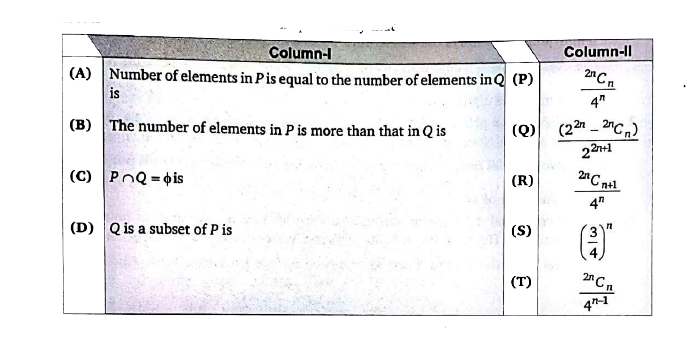A is a set containing n elements, A subset P (may be void also) is selected at random from set A and the set A is then reconstructed by replacing the elements of P. A subset Q (may be void also) of A is again chosen at random. The probability that

(12)n
(14)n
34
(34)n
The correct Answer is:D
The set A has n elements. So, it has 2n subsets.
Therefore, set P can be chosen in 2nC1 ways. Similarly, set Q can also be chosen in 2nC1 ways.
∴ Sets P and Q can be chosen in .2nC1×.2nC1=2n×2n=4n ways.
Suppose P contains r elements, where r varies from 0 to n.
Then, P can be chosen in .nCr ways.
For Q to be disjoint from A, it should be chosen from the set of all subsets of set consisting of remaining n-r elements. This can be done in 2n−r ways. Therefore, P and Q can be chosen in .nCr×2n−r ways.
But, r can vary from 0 to n. Therefore, the total number of ways of selecting P and Q such that they are disjoint is
n∑r=0.nCr2n−r=(1+2)n=3n
Hence, required probability =3n4n=(34)n
Topper's Solved these Questions
- PROBABILITY BOOK - OBJECTIVE RD SHARMA ENGLISHCHAPTER - PROBABILITY EXERCISE - Section- II (Assertion -Reason Types MCQs)
15 Videos
- PROBABILITY BOOK - OBJECTIVE RD SHARMA ENGLISHCHAPTER - PROBABILITY EXERCISE - Section I - Mcqs
89 Videos
- PROBABILITY BOOK - OBJECTIVE RD SHARMA ENGLISHCHAPTER - PROBABILITY EXERCISE - Chapter Test
45 Videos
- PERMUTATIONS AND COMBINATIONSBOOK - OBJECTIVE RD SHARMA ENGLISHCHAPTER - PERMUTATIONS AND COMBINATIONSEXERCISE - Chapter Test
60 Videos
- QUADRATIC EXPRESSIONS AND EQUATIONS BOOK - OBJECTIVE RD SHARMA ENGLISHCHAPTER - QUADRATIC EXPRESSIONS AND EQUATIONS EXERCISE - Chapter Test
50 Videos
Similar Questions
A is a set containing n elements. A subset P of A is chosen at random. The set A is reconstructed by replacing the elements of P. A subset Q is again chosen at random. The probability that P =Q, is
View SolutionA is a set containing n elements. A subset P of A is chosen at random. The set A is reconstructed by replacing the elements of P. A subset Q is again chosen at random. The Probability that P∪Q=A, is
View SolutionA is a set having n elements. A subset P of A is chosen at random. The set A is reconstructed by replacing the elements of A. A subset Q of A is again chosen at random. Find the probability that P and Q have no common elements.
View SolutionLet A be a set containing elements. A subset P of the set A is chosen at random. The set A is reconstructed by replacing the elements of P, and another subset Q of A is chosen at random. The probability that P∩Q contains exactly m(m<n) elements, is
View SolutionA is a set containing n elements. A subset P of A is chosen at random. The set A is reconstructed by replacing the elements of P. A subset Q is again chosen at random. The probability that Q contains just one element more than P, is
View SolutionA is a set containing n elements. A subset P of A is chosen at random. The set A is reconstructed by replacing the elements of P. A subset Q is again chosen at random. The Probability that P and Q have equal number of elements, is
View SolutionA is a set containing n elements . A subet P of
A is chosen at random. The set A is reconstructed by replacing the
elements of P.A subet Q is again chosen at random. The number of
ways of selecting P and Q, is .
View SolutionA is a set containing n elements. A subset P of A is chosen at random. The set A is reconstructed by replacing the elements of P. A subset Q is again chosen at random. The Probability that P∩Q contain just one element, is
View SolutionA is a set containing n elements. A subset P of A is chosen at random. The set A is reconstructed by replacing the elements of P. A subset Q is again chosen at random. The Probability that P∪Q contain just one element, is
View SolutionP is a set containing n elements . A subset A of P is chosen and the set P is reconstructed by replacing the element of A. B such that A and B have no common elements, is
View Solution